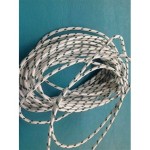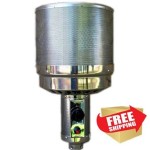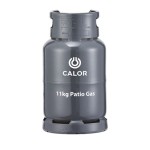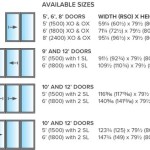Patio Umbrella Heaters: Extending Outdoor Comfort
Patio umbrella heaters are devices designed to provide localized warmth in outdoor settings, primarily under or near patio umbrellas. These heaters offer a practical solution for extending the usability of outdoor spaces during cooler seasons or evenings. Their design aims to maximize efficiency and safety while providing a comfortable heat source for individuals seated beneath the umbrella.
The primary function of a patio umbrella heater is to radiate heat downwards, creating a warm zone within the umbrella's coverage area. This allows people to comfortably enjoy outdoor activities such as dining, socializing, or relaxing even when the ambient temperature is low. These heaters are commonly found in residential patios, decks, restaurants with outdoor seating, and other commercial outdoor areas.
Various factors influence the selection of a patio umbrella heater, including the type of heating element, power source, heat output, safety features, and mounting options. Understanding these factors is crucial for choosing a heater that meets the specific needs of the intended application.
Types of Patio Umbrella Heaters
Patio umbrella heaters are available in several configurations, each utilizing different heating technologies and power sources. The most common types include electric, propane, and natural gas heaters. Each type possesses distinct advantages and disadvantages in terms of cost, heat output, portability, and environmental impact.
Electric Patio Umbrella Heaters: These heaters use electricity to generate heat. They typically feature infrared heating elements, which emit radiant heat that warms objects and people directly rather than heating the air. Electric heaters are often preferred for their convenience, ease of use, and lack of emissions. They require a readily available electrical outlet and are generally quieter than propane or natural gas heaters.
Electric infrared heaters come in various wattage ratings, which directly correlate to their heat output. Lower wattage models are suitable for small patio umbrellas, while higher wattage models can provide heat for larger areas. Some electric heaters also feature adjustable heat settings, allowing users to customize the level of warmth based on their preferences and the prevailing weather conditions.
Another advantage of electric heaters is their relatively low maintenance requirements. They do not require fuel tanks or regular refills, and the heating elements typically have a long lifespan. However, the operational cost of electric heaters can be higher than propane or natural gas heaters, depending on local electricity rates.
Propane Patio Umbrella Heaters: Propane heaters utilize propane gas as their fuel source. These heaters generate heat by burning propane in a controlled manner. Propane heaters are known for their high heat output and portability. They do not require an electrical outlet, making them suitable for areas where electricity is not readily accessible.
Propane heaters typically employ a reflector to direct the heat downwards, maximizing the coverage area. They often include safety features such as tip-over shut-off valves and flame failure devices. However, propane heaters produce emissions, including carbon dioxide and other combustion byproducts. Proper ventilation is essential when using propane heaters in enclosed or semi-enclosed spaces.
The primary disadvantage of propane heaters is the need to regularly refill or replace the propane tank. This can be inconvenient and adds to the operational cost. The size of the propane tank also affects the heater's runtime. Larger tanks provide longer runtimes but can be heavier and more difficult to manage.
Natural Gas Patio Umbrella Heaters: Natural gas heaters operate similarly to propane heaters but use natural gas as their fuel source. These heaters are typically connected to a permanent natural gas line, eliminating the need for fuel tanks. Natural gas heaters offer a consistent and reliable fuel supply, making them suitable for areas with existing natural gas infrastructure.
Natural gas heaters are generally more efficient and environmentally friendly than propane heaters. They produce fewer emissions and are often less expensive to operate, depending on local natural gas rates. However, the installation of a natural gas line can be costly and requires professional expertise. Natural gas heaters are also less portable than propane heaters, as they are permanently connected to the gas line.
The choice between electric, propane, and natural gas heaters depends on several factors, including the availability of power sources, the desired heat output, portability requirements, and environmental considerations. Evaluating these factors carefully will help determine the most suitable heater for a specific application.
Key Considerations for Selecting a Patio Umbrella Heater
Selecting the right patio umbrella heater involves evaluating several key factors to ensure optimal performance, safety, and user satisfaction. These factors include heat output, coverage area, safety features, mounting options, and energy efficiency.
Heat Output and Coverage Area: The heat output of a patio umbrella heater is measured in British Thermal Units (BTUs) or watts. The appropriate heat output depends on the size of the umbrella, the ambient temperature, and the desired level of warmth. Higher heat output is generally required for larger umbrellas or colder environments.
The coverage area of a heater refers to the area that it can effectively warm. This is influenced by the heater's design, reflector size, and heat output. It is important to choose a heater with a coverage area that adequately covers the seating area beneath the umbrella. Some heaters feature adjustable reflectors or heat output settings to customize the coverage area.
Safety Features: Safety is paramount when using any heating appliance. Patio umbrella heaters should include several safety features to prevent accidents and ensure safe operation. These features may include:
- Tip-Over Shut-Off: This feature automatically shuts off the heater if it is accidentally knocked over, preventing potential fires or injuries.
- Flame Failure Device: This device shuts off the gas supply if the flame is extinguished, preventing the release of unburned gas.
- Overheat Protection: This feature prevents the heater from overheating, reducing the risk of fire or damage to the unit.
- Cool-Touch Housing: Some heaters feature a cool-touch housing that prevents accidental burns from contact with the heater's surface.
It is essential to carefully review the safety features of a heater before purchasing it and to follow all safety instructions provided by the manufacturer.
Mounting Options: Patio umbrella heaters are typically designed to be mounted on the umbrella pole or suspended from the umbrella frame. The mounting option should be compatible with the umbrella's design and construction. Some heaters come with adjustable mounting brackets to accommodate different umbrella sizes and configurations.
It is important to ensure that the heater is securely mounted to prevent it from falling or becoming detached. The heater should be positioned so that it does not interfere with the umbrella's operation or create a safety hazard.
Energy Efficiency: The energy efficiency of a patio umbrella heater affects its operating cost and environmental impact. Electric heaters are generally more energy-efficient than propane or natural gas heaters, as they convert a higher percentage of energy into heat. However, the overall cost of operation depends on local electricity rates.
Propane and natural gas heaters can be energy-efficient if they are properly maintained and operated. Regular cleaning and maintenance of the burner and reflector can help to maximize heat output and minimize fuel consumption. Choosing a heater with adjustable heat settings allows users to reduce energy consumption when less heat is needed.
Installation and Maintenance of Patio Umbrella Heaters
Proper installation and maintenance are crucial for ensuring the safe and efficient operation of patio umbrella heaters. Following the manufacturer's instructions and adhering to safety guidelines can help to prevent accidents and prolong the heater's lifespan.
Installation: The installation process varies depending on the type of heater and the umbrella's design. Electric heaters typically require minimal installation, as they simply need to be plugged into a standard electrical outlet. However, it is important to ensure that the outlet is properly grounded and rated for the heater's power consumption.
Propane and natural gas heaters require more involved installation, including connecting the heater to a propane tank or natural gas line. These connections should be made by a qualified professional to ensure that they are secure and leak-free. It is also important to properly ventilate the area around the heater to prevent the buildup of carbon monoxide.
Maintenance: Regular maintenance is essential for keeping patio umbrella heaters in good working condition. This includes:
- Cleaning: Clean the heater regularly to remove dust, dirt, and debris. Use a soft cloth and mild detergent to clean the heater's surface. Avoid using abrasive cleaners or solvents, as they can damage the finish.
- Inspecting: Inspect the heater for any signs of damage or wear. Check the heating element, reflector, gas connections, and electrical cords for cracks, leaks, or fraying. Replace any damaged parts immediately.
- Storing: When the heater is not in use, store it in a dry, protected location. Cover the heater with a tarp or cover to protect it from the elements. Disconnect the propane tank or natural gas line and store them separately.
By following these installation and maintenance guidelines, users can ensure that their patio umbrella heaters operate safely and efficiently for many years to come. Regularly checking the heater and performing necessary maintenance can prevent potential problems and extend the heater's lifespan.
In conclusion, patio umbrella heaters provide a valuable solution for extending the enjoyment of outdoor spaces during cooler weather. Understanding the different types of heaters, key selection considerations, and proper installation and maintenance practices is essential for choosing a heater that meets specific needs and ensures safe and efficient operation.

Industrial Outdoor Stainless Steel Patio Umbrella Gas Heater Lpg China Heaters Garden Made In Com

Parasol Heater Electric Infrared Vasner Umbrella X30

Electric Parasol Heaters In Stock Heat Outdoors

Az Patio Heaters Indoor Outdoor Electric Parasol Heater In Black Com

Umbrella Pole Patio Heater Fire Sense

1500 Watt Foldable Electric Black Patio Heater Umbrella With 3 Heating Panel Am1121c 209 The Home Depot

The Perfect Solution For Commercial Umbrella Heating

Freestanding Umbrella Electric Patio Heater 2100 W Ig9651 Igenix

1500w Hanging Patio Heater Halogen For Outdoor Indoor Living And Home

Portobello 1 5kw Chain Suspended Electric Patio Heater








